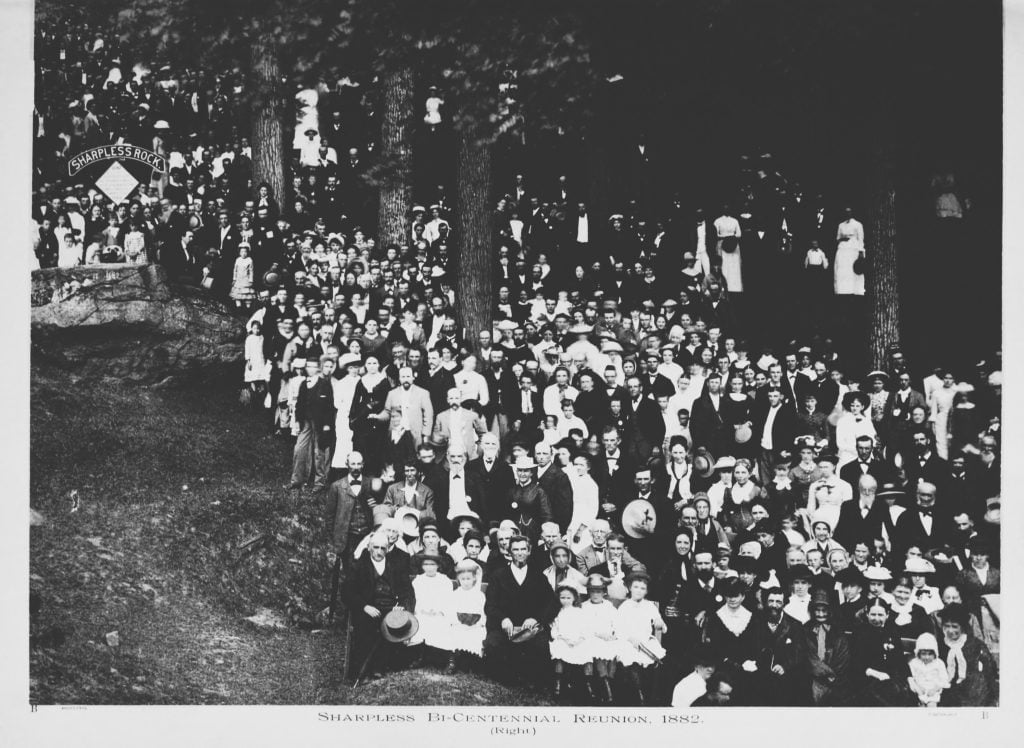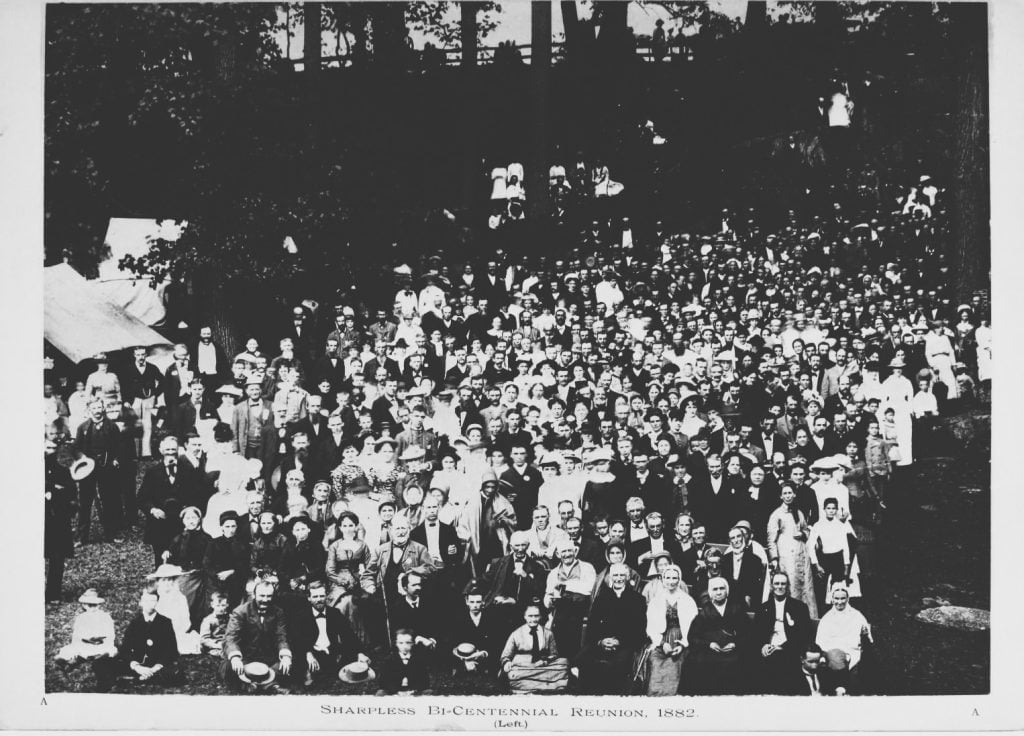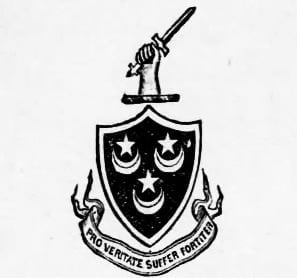Five years after the great family bi-centennial reunion held on 25 August 1882 in Chester County, Pennsylvania, Gilbert Cope published his massive volume on the 200 years of Sharpless family ancestry in America, called “Genealogy of the Sharpless family : descended from John and Jane Sharples, settlers near Chester, Pennsylvania, 1682 : together with some account of the English ancestry of the family, including the results of researches by Henry Fishwick, F.H.S., and the late Joseph Lemuel Chester, LL.D. : and a full report of the bi-centennial reunion of 1882.” This monumental, well-researched tome sought to answer the genealogical and historical questions and answers brought to light from that 1882 reunion. This book is free to search, read, and/or download.
This work is broken into three sections, one section for each son of the first immigrant, John Sharples. Unfortunately, like other surname books of the time, the female lines were recorded only two generations from the Sharpless daughters. The arrangement is by generations, and the names of the children in one generation, if married, are carried forward as parents in the next generation, where they may be readily found by their corresponding numbers. For the sake of economy in space, this order is not strictly adhered to in the later generations.
While this book is searchable, we always advise that you consult the index when available. The index to the book begins on page 1249. The genealogy section begins on page 61, image 97, and is over 1,000 pages long. So lot’s of Sharpless in this book!
Free Digital Book
The Sharpless Family
The following article published in The Philadelphia Times edition of 24 Aug 1882 describes the infamous Sharpless Bi-Centennial Family Reunion.
THE SHARPLESS FAMILY
TRACED BACK TWO CENTURIES
The Host of Descendant of the First Person
of the Name Who Settled in America.
Their English Antecedent and
Coat-of-Arms.
ARMS OF THE SHARPLES FAMILY, 1664
The Sharpless family in the United States hold a reunion today in Chester county around the venerable gray rock where their patriarchal progenitors built their first homestead. Preparations have been made for the accommodation of two over thousand persons, but no attempt at elegance or display has been made, the design being to have the pilgrimage to the family Mecca as simple as possible, in keeping with their quiet and unostentatious entry of two hundred years ago, which it commemorates. Different from many of the early settlers of the country, who came with arms to fight the savages and take from them by force their landed possessions, John Sharpless, like other contemporaries of Penn, came in peace, the enemy of no man, respecting the rights of all and intent only on living soberly and industriously and enjoying liberty of conscience.
The celebration will be out of doors and will probably be very informal. As the greater number to be present will be Friends there will be no dancing, no music, no singing nor any such festal demonstration, but the relatives and descendants who have never seen one another before will come together, get acquainted, talk over the past and its associations and review the family history and traditions. The only exercises will be the reading of several papers and a few poems, all by members of the family. Ezekiel Hunn, Jr., a member of the bar, and grandson of Townsend Sharpless, whose daughter married Ezekiel Hunn, Sr., who lived where the present Broad Street station is situated, will present a paper on ” The Sharpless Family in England previous to coming to America.” Nathan Sharpless, who, like Townsend Sharpless, founder of the business at Chestnut and Eighth streets, is a great-grandson of Joshua, whose grandfather was the first John Sharpless’ son, will read an account of the Sharpless family in America. An original poem will be read by John Clemson Sharpless, of West Chester, who has been the active spirit in arranging to-day’s celebration. Samuel L. Smedley, whose great-grandmother, Hannah Sharpless, the wife of Abraham Pennell, was a granddaughter of John Sharpless youngest son Joseph, will read historical notes containing family traditions and will describe the many valuable heirlooms in the family’s possession. It is expected that there may also be a poem by William Sharpless. The valedictory will be by Washington Townsend, of West Chester, who is also a lineal descendant of Joseph Sharpless, one of the three sons of John. It is the intention to have the oldest immediate member of the family, John Sharpless, who resides on the original family homestead, to preside over the celebration.
THE MEMORIAL ROCK
The Sharpless family, more favored than many others who trace without difficulty their common descent from one sturdy English progenitor who sought the shores of this country for safety from persecution, have the advantage of possessing two important things that give the reunion interest historically as well as genealogically. They are the date when the first John Sharpless landed in the country and the rock on which he built a hut for temporary shelter. There are many descendants of New England ancestors who know that their forefathers came over in the Mayflower, and numerous Pennsylvania families who have satisfying proofs that their ancestors either accompanied Penn and were his friends and companions in founding the colony that has grown into the great Keystone State or else came over here before him, but the descendants of resolute, sturdy and stern – principled John Sharpless, the well-born Quaker, have down in black and white, in his own handwriting, the day when ho landed and have still in the family, handed down from generation to generation, the same land that he got from Penn, the same house that first sheltered the mother and children, and near by on the farm the same curious memorial rock against which a hut was made of a felled tree and its branches soon after landing. The surface of the rock afterwards formed a part of the chimney, which yet bears the name of the family progenitor and the date of his arrival – 1682.
WHOM THE CHILDREN MARRIED
It has been said that the history of the Sharpless family, if it were written, would be the history of Delaware and Chester counties, so long have they lived and owned land in them and so generally have they intermarried with other families. In looking over one of the genealogical charts prepared by Samuel L. Smedley since the idea of having a reunion was broached it is seen that in the first half dozen generations the Sharpless married into families that have sent out from this State some of the strong men and sterling women, who have achieved great prosperity and reached distinction elsewhere. The daughters married such men as George Smedley, Henry Howard, Benjamin Hibberd, Samuel Bond, Aaron Vernon, Joseph Garrett, Thomas Dell, Edward Woodward, Mordecai Taylor, Richard Gorman, Joseph Chamberlain, John Martin, Jacob Pyle, Benjamin Kendal, Isaac Moss, Angustin Parsmore, Richard Bradley, Reuben Roberts, Thomas Swain, Jeremiah Starr, Careb Sherwood, Amos Yarnell, Allen Farquhar, Jonathan Davis, John Eyre and Solomon Mercer. The first three sons married Hannah Pennell, Mary Edge and Lydia Lewis. James, the second brother, marrying a second time and taking Lydia Lewis‘ sister Mary. Some of the Quaker families the grandsons and great-grandsons soughtout for brides are shown by such names on the marriage registers still preserved as Mary Key, Elizabeth Ashbridge, Sarah Coppoch, Princilla Powell, Mary Pyle, Martha Mendenhall, Jane Newlin, Hannah Townsend, Ann Blakey, Hannah Matson, Elizabeth Chaddock, Sarah Paschal1, Jane Harper, Susannah Owen, Mary German, Martha Preston, Hannah Thomas and Sarah Reynolds. These are mostly names which, like that of Sharpless, represent to this day all the broad-brimmed ideas and coal-scuttle integrity of Quaker traditions, but very many of the descendants bearing these names, even as far back as several generations ago, had branched out into the generous living and beauty of personal adornment that in this age, as it was when George Fox and his followers stepped from the beaten track, remain a marked characteristic of people of social rank in the Church of England.
HOW THEY STAY IN THE FOLD
Notwithstanding the long range of two centuries and ten generations, the wide area in which the family was scattered and its intermarriage with other religious denominations, the great portion of the Sharpless family, especially around Philadelphia probably three-fourths of all bearing the name continue in the fold of the Society of Friends, adopt all its formulas and even retain, with occasional slight modifications, the plain garb. In view, however, of the genealogical researches made by Joseph Lemuel Chester, of London, and interrupted by his recent death, going to show that the Sharpless, of Sharples Hail, in Bolton parish, Lancashire, were royal livers and daring riders, it is not surprising to see some of the present youngest ladies of the Philadelphia branch riding gallantly and gracefully their thoroughbreds, following without fear or faltering the hare and hounds, in the Germantown hunts.
The family name was originally spelt Sharples, it appears, and all the members of the family in this county in the earlier generations spelt it that way. The additional s became attached to the name in late years. John Sharples, who came over in 1682, ahead of William Penn, from whom ho had deeds of lease and release for 1,000 acres, which documents, as well as the land, are still in the family possession and will be exhibited to-day, was a man of considerable possessions, as shown by his will, which he made before leaving England lest anything should happen to him, and is yet extant. He had seven children, two of them daughters, and all of them young when he left England. He died three years alter his arrival here. One of the sons died at sea coming over, another died from the bite of a rattlesnake soon after landing and the two daughters did not long survive their father. John, James and Joseph, the three surviving sons, settled on three tracts of land and from them have come every one bearing the name of Sharpless in this country, as well as thousands of descendants bearing other names. From a history of the Sharpless family, written by Joseph Sharpless in 1816, one of the first family histories published in this country, it is learned that John bad 9 children, 34 grandchildren and 188 greatgrandchildren; James had 8 children, 46 grandchildren and 97 great-grandchildren, and Joseph 10 children, 80 grandchildren and 344 greatgrandchildren. In this way it is learned that Joseph, whose descendants are almost all located near this city, bad more grandchildren and great-grandchildren than both his brothers together.
SUFFERING FOR THE FAITH
Mention is made in Besse’s “Sufferings of Friends” that John Sharpless was twice fined in England before leaving for this country, once £16 for refusing to attend parish church and once £20 for attending Friends’ worship. He is known to have been one of George Fox’s immediate and earliest followers, and his three sons after him became earnest and devoted Friends. Only in late years have any of the descendants become professional men. They have usually been occupied as farmers, manufacturers and merchants, but now the family includes clergymen, governors, generals, judges, lawyers and civil engineers, and it is a curious illustration of the workings of time that Bishop Green, of the Protestant Episcopal diocese of Mississippi, who arrived in the city last night and will attend the celebration, should prove to be a direct descendant of the mam who had to flee from the Church of England’s persecution and who was heartily opposed to what was regarded ns a “hireling ministry.” Many other curious things are coming to light. The latest is that they had a fighting Quaker in the family. It has just been found out that David Sharpless, who was a grandson of James, the second son of John, fought in the Revolutionary war and was killed at Red Bank. One of his descendants will be present to-day, with the gun which he then held in his hands. The explanation, it is thought, may lie in the discovery which Colonel Chester made before his death that the Sharpless family is of gentle lineage and has a valid right to the authorized coat-of-arms of the Sharples family in England, which is a sable shield with three crescents argent and between the points of each a mullet d’or, the crest being a hand holding a sword and the motto:
“Pro veritate suffer fortiter.”
Extra train arrangements have been made to get visitors to the grounds near West Chester, and with fair weather the celebration will bring a remarkable gathering and no doubt be an attractive spectacle.
The Philadelphia Times, Philadelphia, Pennsylvania, 24 Aug 1882, Thu > Page 4 > The Sharpless Family


Source
Cope, Gilbert,. Genealogy of the Sharpless family : descended from John and Jane Sharples, settlers near Chester, Pennsylvania, 1682 : together with some account of the English ancestry of the family, including the results of researches by Henry Fishwick, F.H.S., and the late Joseph Lemuel Chester, LL.D. : and a full report of the bi-centennial reunion of 1882. Philadelphia: Published for the family under the auspices of the Bi-Centennial Committee, 1887.

